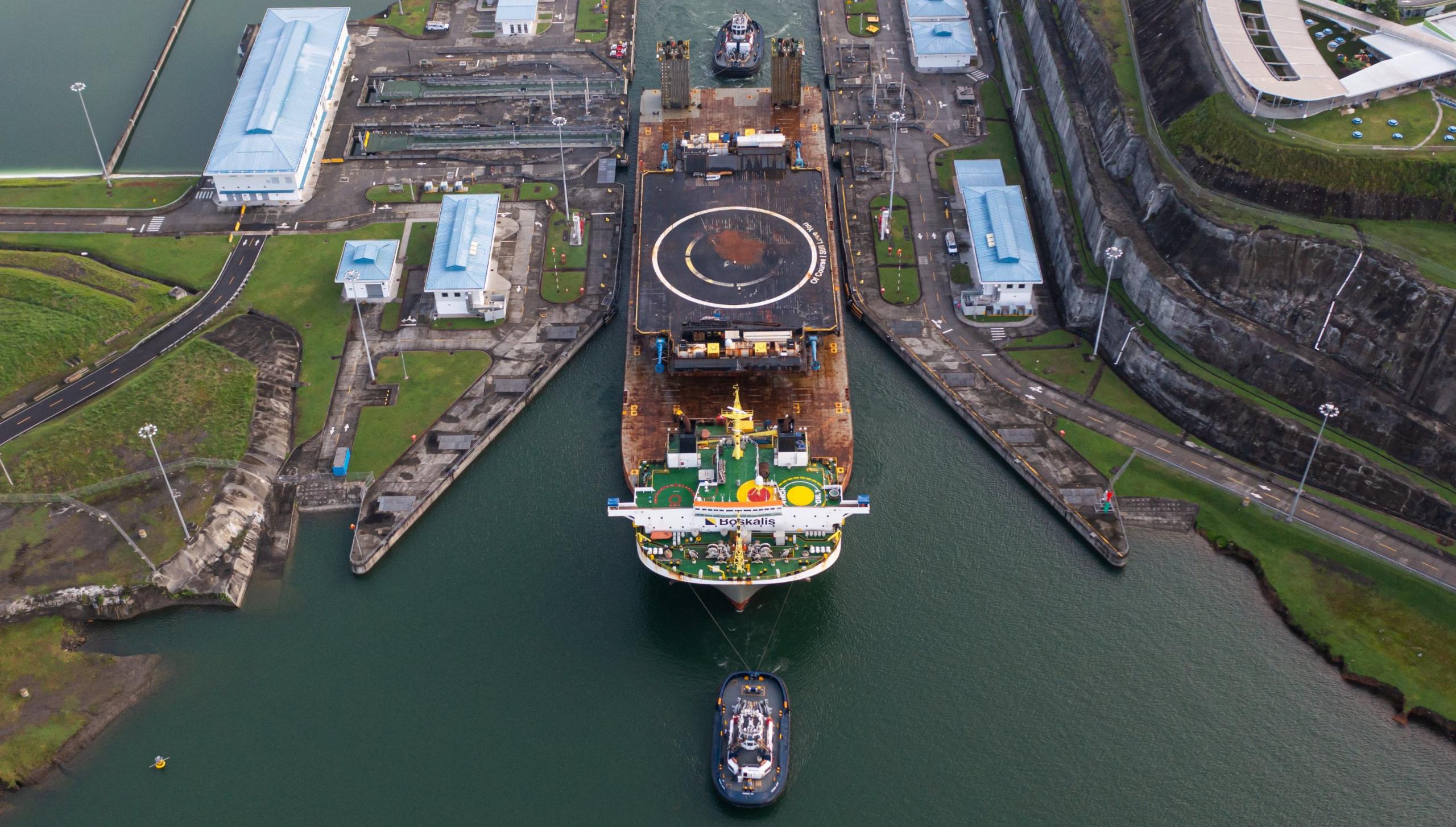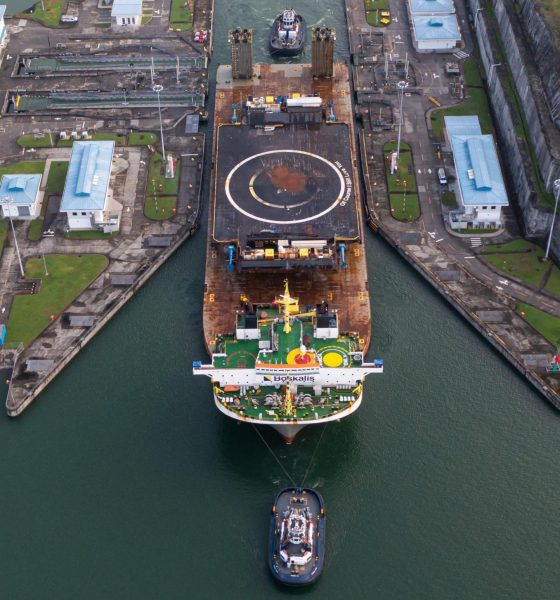

News
SpaceX drone ship sails through Panama Canal on the way to California
For the third time ever, one of SpaceX’s “autonomous spaceport drone ships” has successfully transited the Panama Canal on its way to a new home port.
This time around, similar to drone ship Just Read The Instructions’ (JRTI) original 2015 journey from a Louisiana shipyard to Port of Los Angeles, drone ship Of Course I Still Love You (OCISLY) headed west through the Panama Canal on June 25th, 2021. Unlikely JRTI, though, OCISLY was already operational and had supported almost four dozen successful Falcon booster landings before SpaceX decided to move the storied drone ship from Port Canaveral, Florida to Port of Long Beach, California.
A bit less than four years after Just Read The Instructions debuted on the West Coast, SpaceX sent the drone ship back east in August 2019, leaving the company’s Vandenberg Air/Space Force Base (VAFB) launch pad without an at-sea booster recovery capability ever since. Perhaps unsurprisingly, SpaceX has only launched once out of VAFB in the last two years. Now, though, the company intends to restart West Coast launches with a vengeance – and soon.
SpaceX’s primary motivation: a growing need to deliver a large number of Starlink satellites to polar – rather than semi-equatorial – orbits. Just last month, SpaceX’s 28th dedicated Starlink launch carried the constellation past the 1600-satellite milestones for the first time ever. Comprised of a little over 4400 satellites split between five orbital ‘shells,’ that milestone meant that the Starlink constellation’s first phase is now more than a third complete.
It also means that SpaceX has effectively finished the first of those five shells once all ~1584 satellites finish raising their orbits. A second nearly identical shell of 1584 satellites will eventually complete the constellation’s semi-equatorial foundation. In principle, those two shells of ~3200 satellites are enough to serve internet to ~99% of humanity.
Polar satellites will allow SpaceX to truly provide internet anywhere on Earth. Perhaps most importantly, polar Starlink satellites with optical (i.e. laser) interlinks would allow the constellation to serve uninterrupted, high-quality internet to all aircraft and ships – two major connectivity markets currently trapped with solutions that are either offer a terrible user experience or are extraordinarily expensive (and still mediocre).
Once operational on the West Coast, drone ship OCISLY should allow SpaceX to begin fleshing out Starlink’s polar shells with dedicated launches almost immediately. OCISLY is currently on tracked to arrive at Port of Long Beach around July 6th, leaving SpaceX more than three weeks to prepare for a polar Starlink launch before the month is out. Recently, FCC filings have also indicated that SpaceX intends to perform dedicated polar Starlink launches from California and Florida – though the latter missions will take a significant performance hit to make that happen.
According to Musk, Starlink is about six weeks away from achieving uninterrupted global coverage (excluding the poles) and six months away from offering uninterrupted coverage anywhere on Earth. It’s unclear how much of Starlink’s three polar shells will have to be completed before the constellation can truly provide uninterrupted coverage to those living in Earth’s polar regions but it’s likely that achieving that feat in six months will be a challenge.
Accounting for the inherently less efficient nature of polar launches and assuming approximately 50 Starlink satellites per polar launch, SpaceX will likely need to complete 12-20 polar missions to achieve full global coverage. Though unlikely, both of SpaceX’s first dedicated polar Starlink launches from the East and West Coasts could potentially occur in late July or early August.

News
Tesla FSD fleet is nearing 7 billion total miles, including 2.5 billion city miles
As can be seen on Tesla’s official FSD webpage, vehicles equipped with the system have now navigated over 6.99 billion miles.

Tesla’s Full Self-Driving (Supervised) fleet is closing in on almost 7 billion total miles driven, as per data posted by the company on its official FSD webpage.
These figures hint at the massive scale of data fueling Tesla’s rapid FSD improvements, which have been quite notable as of late.
FSD mileage milestones
As can be seen on Tesla’s official FSD webpage, vehicles equipped with the system have now navigated over 6.99 billion miles. Tesla owner and avid FSD tester Whole Mars Catalog also shared a screenshot indicating that from the nearly 7 billion miles traveled by the FSD fleet, more than 2.5 billion miles were driven inside cities.
City miles are particularly valuable for complex urban scenarios like unprotected turns, pedestrian interactions, and traffic lights. This is also the difference-maker for FSD, as only complex solutions, such as Waymo’s self-driving taxis, operate similarly on inner-city streets. And even then, incidents such as the San Francisco blackouts have proven challenging for sensor-rich vehicles like Waymos.
Tesla’s data edge
Tesla has a number of advantages in the autonomous vehicle sector, one of which is the size of its fleet and the number of vehicles training FSD on real-world roads. Tesla’s nearly 7 billion FSD miles then allow the company to roll out updates that make its vehicles behave like they are being driven by experienced drivers, even if they are operating on their own.
So notable are Tesla’s improvements to FSD that NVIDIA Director of Robotics Jim Fan, after experiencing FSD v14, noted that the system is the first AI that passes what he described as a “Physical Turing Test.”
“Despite knowing exactly how robot learning works, I still find it magical watching the steering wheel turn by itself. First it feels surreal, next it becomes routine. Then, like the smartphone, taking it away actively hurts. This is how humanity gets rewired and glued to god-like technologies,” Fan wrote in a post on X.
News
Tesla starts showing how FSD will change lives in Europe
Local officials tested the system on narrow country roads and were impressed by FSD’s smooth, human-like driving, with some calling the service a game-changer for everyday life in areas that are far from urban centers.

Tesla has launched Europe’s first public shuttle service using Full Self-Driving (Supervised) in the rural Eifelkreis Bitburg-Prüm region of Germany, demonstrating how the technology can restore independence and mobility for people who struggle with limited transport options.
Local officials tested the system on narrow country roads and were impressed by FSD’s smooth, human-like driving, with some calling the service a game-changer for everyday life in areas that are far from urban centers.
Officials see real impact on rural residents
Arzfeld Mayor Johannes Kuhl and District Administrator Andreas Kruppert personally tested the Tesla shuttle service. This allowed them to see just how well FSD navigated winding lanes and rural roads confidently. Kruppert said, “Autonomous driving sounds like science fiction to many, but we simply see here that it works totally well in rural regions too.” Kuhl, for his part, also noted that FSD “feels like a very experienced driver.”
The pilot complements the area’s “Citizen Bus” program, which provides on-demand rides for elderly residents who can no longer drive themselves. Tesla Europe shared a video of a demonstration of the service, highlighting how FSD gives people their freedom back, even in places where public transport is not as prevalent.
What the Ministry for Economic Affairs and Transport says
Rhineland-Palatinate’s Minister Daniela Schmitt supported the project, praising the collaboration that made this “first of its kind in Europe” possible. As per the ministry, the rural rollout for the service shows FSD’s potential beyond major cities, and it delivers tangible benefits like grocery runs, doctor visits, and social connections for isolated residents.
“Reliable and flexible mobility is especially vital in rural areas. With the launch of a shuttle service using self-driving vehicles (FSD supervised) by Tesla in the Eifelkreis Bitburg-Prüm, an innovative pilot project is now getting underway that complements local community bus services. It is the first project of its kind in Europe.
“The result is a real gain for rural mobility: greater accessibility, more flexibility and tangible benefits for everyday life. A strong signal for innovation, cooperation and future-oriented mobility beyond urban centers,” the ministry wrote in a LinkedIn post.
News
Tesla China quietly posts Robotaxi-related job listing
Tesla China is currently seeking a Low Voltage Electrical Engineer to work on circuit board design for the company’s autonomous vehicles.

Tesla has posted a new job listing in Shanghai explicitly tied to its Robotaxi program, fueling speculation that the company is preparing to launch its dedicated autonomous ride-hailing service in China.
As noted in the listing, Tesla China is currently seeking a Low Voltage Electrical Engineer to work on circuit board design for the company’s autonomous vehicles.
Robotaxi-specific role
The listing, which was shared on social media platform X by industry watcher @tslaming, suggested that Tesla China is looking to fill the role urgently. The job listing itself specifically mentions that the person hired for the role will be working on the Low Voltage Hardware team, which would design the circuit boards that would serve as the nervous system of the Robotaxi.
Key tasks for the role, as indicated in the job listing, include collaboration with PCB layout, firmware, mechanical, program management, and validation teams, among other responsibilities. The role is based in Shanghai.
China Robotaxi launch
China represents a massive potential market for robotaxis, with its dense urban centers and supportive policies in select cities. Tesla has limited permission to roll out FSD in the country, though despite this, its vehicles have been hailed as among the best in the market when it comes to autonomous features. So far, at least, it appears that China supports Tesla’s FSD and Robotaxi rollout.
This was hinted at in November, when Tesla brought the Cybercab to the 8th China International Import Expo (CIIE) in Shanghai, marking the first time that the autonomous two-seater was brought to the Asia-Pacific region. The vehicle, despite not having a release date in China, received a significant amount of interest among the event’s attendees.








